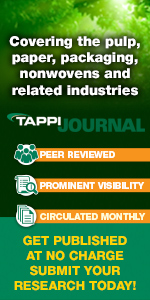 |
||||||||
| July 12, 2017 | ||||||||
| Field Report - The cost of oil leaks |  |
|||||||
|
· Subscribe to Ahead of the Curve · Newsletters · Ahead of the Curve archived issues · Contact the Editor
|
Best Papers highlight new research in Coating & Graphic Arts, Process Control By Monica Shaw (The following is excerpted from the June, 2017 issue of TAPPI Journal, an industry-leading peer-reviewed research publication available every month to TAPPI members.) More than 1750 industry professionals met in Minneapolis, MN, this past April for PaperCon, TAPPI’s annual conference that features a multi-track technical program, seminars, networking, and exhibits. Technical program tracks included coating, papermaking, additives, process control, nonwovens, and fluid dynamics. There were also tracks on mill leadership perspectives and employee retention. Dr. Steve Keller, Process Control Best Paper author, with TAPPI President Larry Montague at the 2017 PaperCon Awards Ceremony. A highlight of this year’s event was the annual PaperCon Awards Dinner, where Honghi Tran, professor in the Department of Chemical Engineering and Applied Chemistry at the University of Toronto, received the Gunnar Nicholson Gold Medal— the highest honor TAPPI bestows on an individual. Among other notable awards given at the dinner were four awards for best PaperCon 2017 and 2016 (assessed after the event) papers described below. Coating & Graphic Arts Division
This paper studied the role of base substrate variables in dispersion coverage and barrier properties. The new generation WBBC solutions used in the study are partly based on bio materials and link together knowledge of both polymer dispersion chemistry and novelty special pigment development. The barrier properties analyzed were KIT test, grease and oil barrier, water vapor, oxygen barrier, and water resistance. The convertibility properties of dispersion coated paper materials were evaluated by creasing tests. The structure of base material was analyzed by different porosity and roughness measurements, such as optical profilometry, SEM, and other microscopy techniques. Coating & Graphic Arts Division This work aims at demonstrating large scale production of flexible low-cost paper-based electrodes using graphene, nano-graphite, and graphite coatings. The large aspect ratio of graphene limits the suspension solids content to very low values, which makes it challenging to create thick coating layers required for high conductivity. The combined use of nanocellulose as binder and viscosity modifier, together with a custom-built slot coating device, enabled roll-to-roll coating of thick conductive coatings on paper. The rheological and water retention properties of carbon-nanocellulose suspensions were reported. The influence of coat weight, carbon black addition, and calendering on coating structure and the resulting conductivity of the coatings was investigated. The lowest surface resistivities obtained were in the range 1-2 Ohm/sq for 15 gsm coat weight. Best Process Control Paper 2016: While the uniform distribution of fibers in the forming section is of paramount importance, imaging and subsequent analysis of paperboard formation has been difficult. Few systems have sufficient energy to penetrate paperboards with grammages values exceeding 120 g/m2 with sufficient sensitivity to determine mass variation at the spatial dimensions useful for characterizing the inherent flocked structures. To find a more precise imaging method with a higher spatial dynamic range, the researchers investigated the use of 6 keV soft X-radiography with both film and storage phosphor screens to obtain a continuous image of paper forma- tion within a 70-mm2 region of interest. This presentation describes the acquisition method for soft X-radiography that enables capture of images suitable for advanced statistical and spectral formation analysis. When using film and scanner, individual fibers throughout the board structure are discernable with high sensitivity and depth of field. Use of storage phosphor systems as the image detector 2 enables rapid imaging at more practical resolutions. From these images, grammages maps are subjected to statistical, spectral, and customized routines. These routines provided statistical pathways to correlate the formation images with other end use properties, such as surface topography and print quality. Jasper Mardon Memorial Prize for From operations and engineering to maintenance and management, control loop analytics target the unique information needs of those groups that are tasked with maximizing uptime and achieving production goals. This presentation covers recent innovations in control loop performance monitoring (CLPM), specifically in context of the pulp and paper industry, to demonstrate the value of loop analytics. The typical paper mill operates hundreds of PID control loops and maintains an even larger quantity of production assets. The typical plant historian stockpiles data, and extracting information that is actionable and relevant to performance can be a challenge. Control loop analytics leverage the information stored in a production facility’s data historian. Technologies like PlantESP actively evaluate PID control loops on a plant-wide basis, identifying issues that undermine production performance and lead to shutdown. These technologies also isolate root causes and recommend corrective actions. Congratulations to the authors and presenters! Their willingness to share their expertise improves our industry. To learn about receiving TAPPI Journal, visit tappi.org and click the Publications & Standards tab; for information about presenting a paper at a TAPPI event, click the Events tab. Monica Shaw is editorial director, TAPPI Journal. She has more than 20 years of professional writing experience, with 11 years in b2b publishing as an editor with Pulp & Paper magazine and contributing editor with Tissue World and PPI magazines.
For a modest investment of $174, receive more than US$ 1000 in benefits in return. |
|||||||
 |
||||||||

